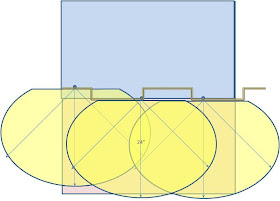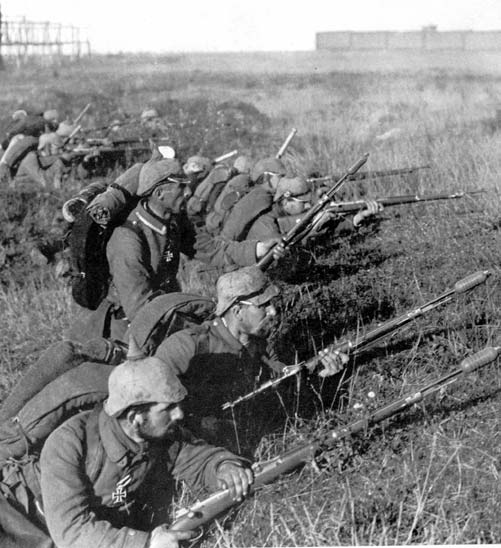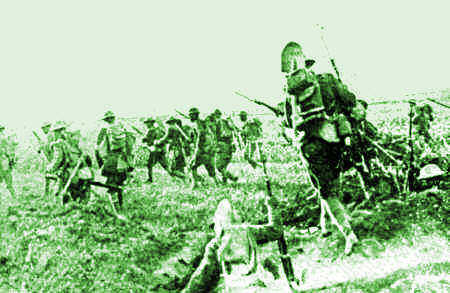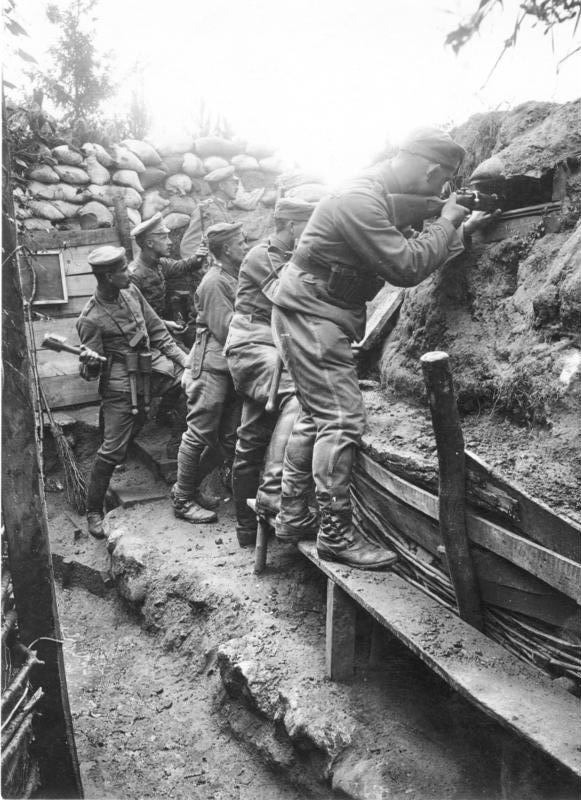In our first episode, a raiding party of 73rd (Royal Highlanders of Canada) had snuck through the shell-cratered muddy ruin that lay between them and the German lines, hoping to grab a prisoner or two and find out what was going on in the German lines. Between alert sentries and a brilliant moon (unexpectedly revealed), the Canucks had faced an impossible assignment and withdrew with a number of casualties and some shattered pride.
On the east side of the battlefield, this raid had caused some Teutonic brows to furrow. Why were the Canadians probing at such an inauspicious time? Any sensible commander would have waited until the moon had thinned, rather than counting on clouds for protection. There must be a strong imperative to acquire information or to disrupt German operations. A small scout group was sent across to see if there were signs of preparations for attack (and, incidentally, to repair the wire the enemy had cut in their approach).
Alas, the best-laid plans of mice and men...
Feldwebel Schenk, an experienced soldier, slipped on an odd-shaped piece of stone (on inspection, it proved to be an old, battered British mess tin) as the scouting party was nearing the British lines. He sustained a severe ankle injury and, though he did his best to manfully stifle the shriek of pain that followed the tearing of muscle and snapping of bone, the commotion that ensured was sufficient to draw a strong British wiring party towards the German
gruppe. Sending his men back to their lines, Schenk snapped off a few shots at the approaching Canadians, enough to keep their heads down until his men were well away. Then he put up his hands. Since he had not actually hit any of them, his captors were not inclined to mistreat him too fervently, and he was more or less intact when delivered to the A Company command dugout for interrogation.
Back at
1te Batallion, Reserve-Infanterie-Regiment Nr. 261, there was consternation. Fw. Schenk was a valuable man. He had trained half the patrol leaders in the
Kompanie. He was the
Leutnant's right-hand man. He had to be rescued. Lt. Thundertentronck himself resolved to take a picked group of men, half a section, and retrieve the experienced
landser before he was carted off to an Allied rear area. A
Vizefeldwebel tried to reason with the young man, but to no avail. Ir. 261 didn't leave a man behind!
The night was quiet. A little too quiet for anyone's liking. It would have been nice to have a nearby barrage, or perhaps some flares going up half a mile away to keep the North Americans distracted. As the three
gruppen made their way through the night, it seemed that the moon was, again, like a giant flood light, aimed right at their feet. As they neared the enemy front line trench, the
Unteroffizieren urged silence on their men, and advances were taken in little rushes, a dozen yards and then a drop to the ground, finding whatever cover was available. After a moment or two, a stealthy rise into a crouch, and a dozen more yards would be trodden under their boot heels.
Lt Thundertentronck waited with two runners. He had pointed one
gruppe to the gap in the wire on the left. Another had moved forward swiftly towards the gap on the right, but they were moving through the near gap at the same time as the first, and so blocked the movement of the third group. Earnest and full of initiative, but perhaps too impatient, that group's
Gefreiter had decided to cut an additional gap in the near wire, since they couldn't move directly forward.
"Well, it will keep them occupied," thought the
Leutnant. He motioned to to his runners and ran through the clearing (original) gap. The second group has slowed, and he found himself racing ahead of them. Turning, he glared and beckoned at their NCO, urging him soundlessly to keep up.
Soundlessness was not something, it rapidly became evident, that the
Leutnant should have worried about. Only moments after shouting and whistles showed that their cover was blown, the abrupt and deadly voice of a British
Maschinengewehr could be distinctly heard. Uffz. Grauber was screaming at his men, urging them to hurry as bullets began tearing through his position. Helmets could be seen, here and there, showing movement into the front-line trench. The
Leutnant reached into his breadbag and pulled out the flare pistol he'd been issued; the line directly in front of them, which had a communications trench running back from it, was no longer a practical objective. But he could deny it to the enemy.
It seemed the shot had barely arced into the sky and burst when the supporting barrage began coming down. Was it trench mortars from their own unit, rather than howitzers from the
Feldartillerie? No way to tell, but no one in those trenches would be moving now. He waved the pistol, trying to point Grauber and the other NCOs toward the trenchline to their right. Could they see him? Hard to tell--the flare was so bright, he could barely open his now night-sensitive eyes. Best to lead by example. He leapt to his feet and began running.
Grauber could see the direction, and it was unnecessary. He was headed that way anyway. The problem was his men. The machinegun fire was deterring them. Some of them were evidencing this deterrence by shrinking back and trying to find shelter in shell holes instead of moving forward. Others were manifesting their unwillingness in a more passive way, by lying huddled on the ground while bullet after bullet slammed into their motionless forms. After his latest round of shouting (over the combined noise of the British Vickers and the German shells impacting less than fifty metres away), he realised he was alone. Quite alone. Well, another
gruppe was heading through the other gap in the wire; he would go join them.
This was, as it happened, a good idea. Hesitating briefly at the wire gap to get his bearings, Uffz. Meier had noticed more movement in the opposing trench. There was a dogleg just to the right of the traverse he had decided to head for, and it looked as if there were men with rifles entering the traverse. One of them even seemed to be pointing his rifle towards Meier....

The crackle of fire to his right alarmed von Thundertentrock. But this was supposed to be the one empty section! He and his runners paused briefly on the edge of the trench, then jumped in. He turned back to see how close his
gruppen were. Not very. A figure that looked (and certainly sounded) like Grauber was standing with what seemed to be Meier's
gruppe, urging them to move towards the trench. Grauber's own
gruppe seemed to have disappeared. And Gfr. Kaufmann's men, having finished their (somewhat unnecessary) wire-clearing activity seemed to be hesitating about coming further forward. "We'll just guard this gap," he could hear them thinking, "and cover the other men when they retreat. Maybe we'll have a pipe while we wait..."
The
Leutnant looked ahead towards where he believed the enemy command bunker (his objective) to be. A section of enemy infantry filled the trench that accessed it, and his own interdiction barrage was falling all around it. Off to his right, the small group of enemy riflemen that had recently appeared were getting bolder. And off on the far side of his barrage, there were shouts and cries that suggested the enemy's ready-reaction force had arrived and was looking for a way through the barrage to come to grips with him. He looked around him. Two men in the enemy trench with him. About a dozen more, yards away and getting no closer. Schenk, if he were even still in the area, stowed away in the unreachable enemy
Gefechtsstand.
"It's no good, lads," he shouted to his runners. "We're not going to make it through this time. Let's get the rest of the men and get them back to our lines." So near, but yet so far...
***********************************************************************************
Our second game of Winter Sports ended much like the first. We tried having advancing groups use one Action to move and another to take cover, hoping that this would make it harder for the sentries to accumulate Whistle Points. But doing so slowed the pace of the advance; using one Action to take cover doubled the length of time the advance took, but it did not make spotting the men even twice as hard. It was proving impossible for the attackers to come even close to the defending trench before, not only the frontline troops but also the machinegun and relief forces were alerted and active. We would have to make some changes if the scenarios were going to work as intended.
 Our latest Mud and Blood engagement saw us introducing a few new players to the mix, so it seemed as if we should be expanding the scope of the battle, at leas a little bit. So, since we were looking to train up some new eggs, we turned the the "Training the Entente" section of the Stout Hearts and Iron Troopers supplement to M&B. Up first is the scenario "Attack on a Strongpoint", which comes more or less straight from Appendix X of the British Army's manual SS143, 'Instructions for the training of platoons for offensive action', 1917.
Our latest Mud and Blood engagement saw us introducing a few new players to the mix, so it seemed as if we should be expanding the scope of the battle, at leas a little bit. So, since we were looking to train up some new eggs, we turned the the "Training the Entente" section of the Stout Hearts and Iron Troopers supplement to M&B. Up first is the scenario "Attack on a Strongpoint", which comes more or less straight from Appendix X of the British Army's manual SS143, 'Instructions for the training of platoons for offensive action', 1917.













